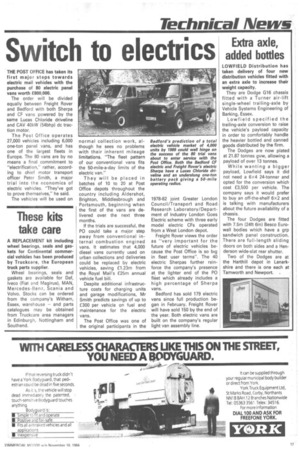THE POST OFFICE has taken its first major steps towards
Page 19

If you've noticed an error in this article please click here to report it so we can fix it.
electric mail vehicles with the purchase of 80 electric panel vans worth £800,000.
The order will be divided equally between Freight Rover and Bedford with both Sherpa and CF vans powered by the same Lucas Chloride driveline and CAV 40kW (54bhp) de traction motor.
The Post Office operates 27,000 vehicles including 6,000 one-ton panel vans, and has one of the largest fleets in Europe. The 80 vans are by no means a final commitment to "electrification," rather, according to chief motor transport officer Peter Smith, a major trial into the economics of electric vehicles. "They've got to prove themselves," he said.
The vehicles will be used on normal collection work, although he sees no problems with their inherent mileage limitations. "The fleet pattern of our conventional vans fits the 50-mile-a-day limits of the electric van."
They will be placed in batches of 10 to 24 at Post Office depots throughout the country including Aldershot, Brighton, Middlesbrough and Portsmouth, beginning when the first of the vans are delivered over, the next three months.
If the trials are successful, the PO could take a major step away from conventional internal combustion engined vans. It estimates that 4,000 diesel vans currently used on urban collections and deliveries could be replaced by electric vehicles, saving £1.23m from the Royal Mail's £25m annual vehicle fuel bill.
Despite additional infrastructure costs for charging units and garage modifications, Mr Smith predicts savings of up to £300 per vehicle on fuel and maintenance for the electric vans.
The Post Office was one of the original participants in the 1978-82 joint Greater London Council/Transport and Road• Research Laboratory/Department of Industry London Goes Electric scheme with three early model electric CFs operated from a West London depot.
Freight Rover views the order as "very important for the future of electric vehicles because the Post Office is so big in fleet user terms". The 40 electric Sherpas further reinforce the company's presence at the lighter end of the PO fleet which already includes a high percentage of Sherpa vans.
Bedford has sold 179 electric vans since full production began in February. Freight Rover will have sold 150 by the end of the year Both electric vans are built on the company's regular light van assembly line.




































































































